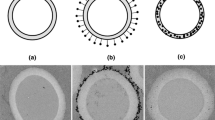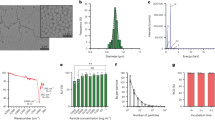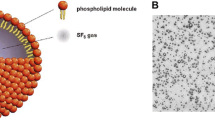Abstract
Particulate contrast media offer exciting advantages over water-soluble media in several radiologic applications. A truly vascular contrast medium which does not diffuse into the extravascular spaces and is not hyperosmolar would be extremely useful as an intravenous angiographic medium for measuring blood flow and vascular volumes with the novel technologies such as digital fluoroscopy and dynamic computed tomography (CT) scanning. A medium which is less viscous than Ethiodol and does not embolize in the lungs would be advantageous in lymphography. The difference in impedance between solids and liquids means particulate media could potentially be useful as ultrasound contrast media (CM). Paramagnetic compounds in the form of a particulate suspension may be helpful as nuclear magnetic resonance (NMR) contrast media.
Access this chapter
Tax calculation will be finalised at checkout
Purchases are for personal use only
Preview
Unable to display preview. Download preview PDF.
Similar content being viewed by others
References
Thomas SF, Henry GW, Kaplan HS (1953) Hepatolienography: past, present, and future. Radiology 57:669–683
Fischer HW (1977) Improvement in radiographic contrast media through the development of colloidal or particulate media: an analysis. J Theor Biol 67:653–670
Swarm RL (1971) Colloidal thorium dioxide. In: International encyclopedia of pharmacology and therapeutics. Radioactive agents, section 76. Pergamon
Carrigan RH (1967) Manufacture of thorium dioxide suspension (Thorotrast). Ann NY Acad Sci 145:530–531
Thomas SF (1962) Hepatolienography ten years later. Radiology 78:435–438
Radt P (1929) Eine Methode zur röntgenologischen Kontrastdarstellung von Milz und Leber. Klin Wochenschr 8:2128–2129
Oka M (1929) Eine neue Methode zur röntgenologischen Darstellung der Milz. Fortsch Geb Röntgenstr 40:497–501
Fischer HW (1957) Colloidal stannic oxide: animal studies on a new hepatolienographic agent. Radiology 68:488–498
Fischer HW, Zimmerman GR (1969) Long retention of stannic oxide: lack of tissue reaction in laboratory animals. Arch Pathol 88:259–264
Gianturco C, Ruskin B, Steggerda FR, Takeochi T (1972) A feasibility study of splenohepatography with tantalum metal and tantalum pentoxide. Radiology 102:195–196
Teplick GJ, Berk JE, Safrin L (1957) Experimental hepatosplenography using barium sulfate. Exp Hepatosplenography 78:328–332
Seltzer SE, Adams DF, Davis MA, Hessel SJ, Hurlburt A, Havron A, Hollenberg NK, Abrams HL (1979) Development of selective hepatic contrast agents for CT scanning. Invest Radiol 14:356–357
Violante MR, Fischer HW, Mahoney JA (1980) Particulate contrast media. Invest Radiol 15:5329–5334
Fischer HW, Barbaric ZL, Violante MR, Stein G, Shapiro ME (1977) Iothalamate ethyl ester as hepatolienographic agent. Invest Radiol 12:96–100
Violante MR, Shapiro ME, Fischer HW (1979) Protein binding to iothalamate ethyl ester. Invest Radiol 14:177–179
Felder E (1977) Radiopaque esters of tetra-dodoterephthalic acid. US patent 4,044,048
Matthews JL (1955) An evaluation of various avenues available for visualization of the liver with X-rays. Doctoral thesis, University Illinois, Department of Physiology
Drummel RJ, Madden JD, Thomas SF (1959) New iodine compounds for hepatolienography. J Am Pharm Assoc Sci Ed 48:181–182
Zimmon DS, Hadgraft JW (1965) A new method for hepatolienography. Radiology 84:477–482
Wiedeman MP (1963) Dimensions of blood vessels from distributing artery to collecting vein. CircRes 12:375–378
Gendreau RM, Jakobsen RJ (1979) Blood-surface interactions: fourier transform infrared studies of protein surface adsorption from flowing blood plasma and serum. J Biomed Mater Res 13:893–906
Baier RE (1975) Applied chemistry at protein interfaces. Adv Chem Ser 145:1
Leininger RI (1972) Polymers as surgical implants. CRC Crit Rev Bioeng 1:333–381
McIntire LV (1980) Dynamic materials testing: biological and clinical applications in network-forming systems. Annu Rev Fluid Mech 12:159–179
Pearsall NN, Weiser RS (1970) The macrophage. Lea and Febinger, Philadelphia, pp 62–63
Van Aken WG, Vreeken J (1970) The clearance mechanism of the reticuloendothelial system. In: Van Furth R, Davis FA (eds) Mononuclear phagocytes. Blackwell, Philadelphia, pp 382–396
Remuzzi G, Mecca G, Marchesi D et al. (1979) Platelet hyperaggregability and the nephrotic syndrome. Thromb Res 16:345–354
Grosse-Siestrup G, Olsen DB, Lemm W (1978) A long-term ex vivo shunt for blood compatibility of biomaterials. Trans Soc Biomater 2:102
Lee RG, Kim SW (1974) Adsorption of proteins onto hydrophobic polymer surfaces: adsorption isotherms and genetics. J Biomed Mater Res 8:251
Cooper EH, Ward AM (1979) Acute phase reactant proteins as aids to monitoring disease. Invest Cell Pathol 2:293–301
Watkins RW, Robertson CR (1977) A total internal-reflection technique for the examination of protein adsorption. J Biomed Mater Res 11:215–238
Davis BD (1946) Physiological significance of the binding of molecules by plasma proteins. Am Sci 34:611–618
Tait J, Elvidge AR (1926) Effect upon platelets and on blood coagulation of injecting foreign particles into the blood stream. J Physiol 62:129–144
Biozzi G (1951) Quantitative study of the granulopectic activity of the reticuloendothelial system by intravenous injection of India ink in various animal species. V. Relations between the modifications of blood coagulation in vitro under the effect of intravenous injections of increased doses of India ink and its distribution in the organism. Am Inst Pasteur 81:164–172
Pfueller SL, Firkin BG (1978) Role of plasma proteins in the interaction of human platelets with particles. Thromb Res 12:979
Vroman L, Adams AL, Klings M et al. (1977) Reactions of formed elements of blood with plasma proteins at interfaces. Ann NY Acad Sci 283:65
Zucker MB, Vroman L (1969) Platelet adhesion induced by fibrinogen adsorbed onto glass. Proc Soc Exp Biol Med 131:318
Walton KW (1953) Obervations on the effects of a series of dextran sulphates of varying molecular weight on the formed elements of the blood in vitro. Br J Pharmacol 8:340–347
Walton KW (1954) Investigation of the toxicity of a series of dextran sulphates of varying molecular weight. Br J Pharmacol 9:1–14
Bell E (1953) The origin and nature of granules found in macrophages of the white mouse following intravenous injection of thorotrast. J Cell Comp Physiol 42:125–136
Violante MR, Mare K, Fischer HW (1981) Biodistribution of a particulate hepatolienographic CT contrast agent. A study of iodipamide ethyl ester in the rat. Invest Radiol 16:40–45
Violante MR, Dean PB (1980) Improved detectability of VX 2 carcinoma in the rabbit liver with contrast enhancement in computed tomography. Radiology 134:237–239
Alfidi RJ, Luval-Jeantet M (1976) AG 60.99: a promising contrast agent for computed tomography of the liver and spleen. Radiology 121:491
Vermess M, Chatterji DC, Doppman JL et al. (1979) Development and experimental evaluation of a contrast medium for computed tomographic examination of the liver and spleen. J Comput Assist Tomogr 3:25–31
Vermess M, Doppman JL, Sugarbaker P et al. (1980) Clinical trials with a new intravenous liposoluble contrast material for computed tomography of the liver and spleen. Radiology 137:217–222
Lamarque JL, Bruel JM, Dondelinger R et al. (1979) The use of iodipids in hepatosplenic computed tomography. J Comput Assist Tomogr 3:21–24
Spector WS (1956) (ed) Handbook of biological data. Saunders, Philadelphia, p 163
Bluin A (1979) Morphometry of liver sinusoidal cells. In: Wisse E, Knook DL (eds) Kupffer cells and other liver sinusoidal cells, 2nd ed. Elsevier, Amsterdam, pp 61–72
Beuacerraf B, Biozzi G, Halpern BN et al. (1957) Physiology of phagocytosis of particles by the reticuloendothelial system. In: Halpern BN (ed) Physiopathology of the reticuloendothelial system. Thomas, Springfield, pp 52–79
Saba T (1970) Physiology and physiopathology of the reticuloendothelial system. Arch Intern Med 126:1031–1052
Dobson EL, Gofman JW, Jones HB, Kelly LS, Walker LA (1949) Studies with colloids containing radioisotopes of yttrium, zerconium, columbium, and lanthanum. II. The controlled selective localization of radioisotopes of yttrium, zerconium, and columbium in the bone marrow, liver, and spleen. J Lab Clin Med 34:305–312
Dobson EL, Jones HB (1952) The behavior of intravenously injected particulate material. Acta Med Scand [Suppl] 273:7–71
Kabisch WT (1967) Phagocytosis of colloidal thorium dioxide and cobaltic oxide by the reticuloendothelial system of the rat. Ann NY Acad Sci 145:585–594
Singer JM, Adlersbert L, Hoenig EM, Ende E, Tchorsch Y (1969) Radiolabeled latex particles in the investigation of phagocytosis in vivo: clearance and histological observations. J Reticuloendothel Soc 6:561–589
Nelp WB (1970) Distribution and radiobiological behavior of colloids and macroag-gregates. In: Cloutier RJ, Edwards CL, Snyder W (eds) Medical radionuclide: radiation dose and effects. USAEC Symposium Series 20, Springfield
Drinker CK, Shaw LA (1921) Quantitative distribution of particulate material (mangenese dioxide) administered intravenously to the cat. J Exp Med 33:77–98
Dobson EL (1957) Factors controlling phagocytosis. In: Halpern BN (ed) Physiopathology of the reticuloendothelial system. Thomas, Springfield, pp 80–114
Jones HB, Wrobel CJ, Lyons WR (1944) A method of distributing beta-radiation to the reticuloendothelial system and adjacent tissues. J Clin Invest 23:783–788
Neukomm S, Lerch P, Jallut O (1957) Physicochemical factors governing the phagocytic function of the RES. In: Halpern BN (ed) Physiopathology of the reticuloendothelial system. Thomas, Springfield, pp 115–127
Zilversmit DB, Boyd GA, Brucker M (1952) The effect of particle size on blood clearance and tissue distribution of radioactive gold colloids. J Lab Clin Med 40:255–260
Wilkins DJ, Myers PA (1966) Studies on the relationship between the electrophoretic properties of colloids and their blood clearance and organ distribution in the rat. Br J Exp Pathol 47:568–576
Curtis ASG (1960) Cell contacts: some physical considerations. Am Nat 94:37–56
Steinberg MS (1958) On the chemical bonds between animal cells. A mechanism for type-specific association. Am Nat 92:65–81
Benor S, Eisenberg S, Doljanski F (1960) Electrophoretic mobilities of normal and regenerating liver cells. Nature 188:1200–1201
Benacerraf B, Halpern BN, Biozzi G, Benos SA (1954) Quantitative study of the granulopectic activity of the reticulo-endothelial system. III. The effect of cortisone and nitrogen mustard on the regenerative capacity of the RES after saturation with carbon. Br J Exp Pathol 35:97–106
Biozzi G, Benacerraf B, Halpern BN (1953) Quantitative study of the reticulo-endothelial system. II. A study of the granulopectic activity of the RES in relation to the dose of carbon injected. Relationship between the weight of the organs and their activity. Br J Exp Pathol 34:441–457
Halpern B (1974) Role of the reticulo-endothelial system in the clearance of macro-molecules. In: Jager JM, Houghwinke GJM, Daems WJH (eds) Liposomal therapy in lysosomal disease. Elsevier, Amsterdam, pp 111–123
Norman SJ (1974) Kinetics of phagocytosis. II. Analysis of in vivo clearance with demonstration of competitive inhibition between similar and dissimilar foreign particles. Lab Invest 31:161–169
Norman SJ (1974) Kinetics of phagocytosis. III. Two colloid reactions, competitive inhibition, and degree of inhibition between similar and dissimilar foreign particles. Lab Invest 31:286–293
Ito M, Wagner HN, Scheffel U, Jabbour B (1963) Studies of the reticuloendothelial system. I. Measurement of the phagocytic capacity of the RES in man and dog. J Clin Invest 42:417–426
Jacques PJ (1977) Kinetics of test-particle extraction from blood plasma by liver and spleen macrophages. In: Wisse E, Knook DL (eds) Kupffer cells and other liver sinusoidal cells. Elsevier, Amsterdam
Bradfleld JWB (1977) Reticulo-endothelial blockade: a reassessment. In: Wisse E, Knook DL (eds) Kupffer cells and other liver sinusoidal cells. Elsevier, Amsterdam, pp 365–372
Dobson EL, Kelly LS, Finney CR (1967) Kinetics of the phagocytosis of repeated injections of colloidal carbon: blockade, a latent period of stimulation? A question of timing and dose. Adv Exp Med Biol 1:63–73
Murray IM, Katz M (1955) Factors affecting the rate of removal of gelatin-stabilized radiogold colloid from the blood. J Lab Clin Med 46:263–269
Keith WS, Briggs DR (1930) Roentgen ray visualization of spleen following injection of emulsions of halogenated oils. Proc Soc Exp Biol Med 27:538–540
Beckermann F, Popken C (1938) Kontrastdarstellung der Leber und Milz im Röntgenbild mit Jodsolen. Fortschr Röntgenstr 58:519–535
Derkwitz R (1938) Kolloidgestaltung und gezielte intravenöse Injection. Fortschr Röntgenstr 58:472–485
Olsson O (1944) On hepatosplenography with jodsol. Acta Radiol 22:749–761
Berger SM (1956) Angiopac, ethyl di-iodostearate as a hepatosplenographic agent. Preliminary report. AJR 76:39–46
Teplick JG, Haskin ME, Skelley J et al. (1964) Experimental studies with a new radiopaque emulsion. Radiology 82:478–485
Vermess M, Adamson RH, Doppman JL et al. (1974) Intra-arterial hepatography: experimental evalulation of a new contrast agent. Radiology 110:705–707
Laval-Jeantet M, Lamarque JL, Dreux P et al. (1976) Hepatosplenography by intravenous injection of a new iodized oily emulsion. Acta Radiol [Diagn] 17:49–60
Baitaxe HA, Katzen B, Alonzo DR et al. (1976) Hepatomography: an experimental technique using an emulsifier. A preliminary study. Radiology 119:27–30
Vermess M, Adamson RH, Doppman JL et al. (1977) Computed tomographic demonstration of hepatic tumor with the aid of intravenous iodinated fat emulsion. An experimental study. Radiology 125:711–715
Grimes G, Vermess M, Gallelli JF et al. (1979) Formulation and evaluation of ethiodized oil emulsion for intravenous hepatography. J Pharm Sci 68:52–56
Vermess M, Inscoe S, Sugarbaker P (1980) Use of liposoluble contrast material to separate left renal and splenic parenchyma on computed tomography. J Comput Assist Tomogr 4:540–542
Wretlind A (1964) The pharmacological basis for the use of fat emulsions in intravenous nutrition. Acta Chir Scand [Suppl] 325:31–42
McCready R (1972) Scintigraphic studies of space-occupying liver disease. Nuklearmedizin 42:108–127
Long DM, Liu M-S, Szanto PS, Alrenga DP, Patel MM, Rios MV, Nyhus LM (1972) Efficacy and toxicity studies with radiopaque perfluorocarbon. Radiology 105:323–332
Long DM, Liu M-S, Szanto PS, Alrenga P (1972) Initial observations with an X-ray contrast agent — radiopaque perfluorocarbon. Rev Surg 29:71–76
Liu MS, Long DM (1976) Biological disposition of perfluoroctylbromide: tracheal administration in alveolography and bronchography. Invest Radiol 11: 479–485
Liu MS, Long DM (1977) Perfluoroctylbromide as a diagnostic contrast medium in gastroenterolography. Radiology 122:71–76
Enzman D, Young SW (1979) Applications of perfluorinated compounds as contrast agents in computed tomography. J Comput Assist Tomogr 3(4):622–626
Paphadjopoulos D, Wilson T, Taber R (1980) Liposomes as vehicles for cellular incorporation of biologically active macromolecules. In Vitro 16(l):49–54
Gregoriadis G, Ryman BE (1972) Lysosomal localization of fructofuranosidase-containing liposomes injected into rats. Biochem J 129:123
McDougall IR, Dunnick JF, McNamee MG, Kriss JP (1974) Distribution and fate of synthetic lipid vesicles in the mouse: a combined radionuclide and spin label study. Proc Natl Acad Sci USW 71:3487
Rahman Y, Wright BJ (1975) Liposomes containing chelating agents. J Cell Biol 65:112
Rahman Y, Rosenthal MW, Cerny EA, Moretti ES (1974) Preparation and prolonged tissue retention of liposome-encapsulated chelating agents. J Lab Clin Med 83:640
Rahman Y, Cerny EA, Tollaksen SL, Wright BJ, Nance SL, Thomson JF (1974) Liposome-encapsulated actinomycin D: potential in cancer chemotherapy. Proc Soc Exp Biol Med 146:1173
Straub SX, Garry RF, Magee WE (1974) Interferon induction by poly (I): poly (C) enclosed in phospholipid particles. Infect Immun 10:783
Havron A, Seltzer SE, Davis MA (1980) Liposomes containing diatrizoate: a promising new contrast agent for splenic computed tomography (CT). 66th RSNA, Dallas, Texas, Nov 1980
Felder E, Pitre D, Tirone P, Zingales MF (1978) Radiopaque contrast media. XLV experimental lymphography with crystal suspensions. Farmaco 33:302–314
Chiappa S, Campani R, Felder E, Ferrari D, Tirone P (1979) Experimental lymphography by intratissue injection of a crystal suspension. In: Malek P, Bartos V, Werssleder H, Witte MH (eds) Proceedings of the VIth international congress, Prague 1977. Thieme, Stuttgart, pp 359–362
Gold WM, Yonker J, Anderson S, Nadel JA (1965) Pulmonary function abnormalities after lymphangiography. N Engl J Med 273:519
Johansson S, Sternby NH, Theander G, Wehlin L (1966) Iodinated oil emulsion for lymphography. Acta Radiol 4:690
Ansell G (1970) Adverse reactions to contrast agents: scope of problem. Invest Radiol 5:374–384
Shehadi WH (1975) Adverse reactions to intravascularly administered contrast media: a comprehensive study based on a prospective survey. AJR 124:145–152
Bjork L, Erikson J, Ingleman B (1969) Clinical experience with a new type of contrast medium in carotid arteriography. AJR 107:637–640
Hilal SK (1970) Trends in preparation of new angiographic contrast media with special emphasis on polymeric derivatives. Invest Radiol 5:458–468
Almen T, Wiedeman MP (1968) Application of monomers and polymers to the external surface of the vasculature: effects on microcirculation in the bat wing. Invest Radiol 3:408–413
Dean PB, Kivisaari L, Kormano M (1978) The diagnostic potential of contrast enhancement pharmacokinetics. Invest Radiol 13:533–540
Newhouse JH (1977) Fluid compartment distribution of intravenous iothalamate in the dog. Invest Radiol 12:364–367
Editor information
Editors and Affiliations
Rights and permissions
Copyright information
© 1984 Springer-Verlag Berlin Heidelberg
About this chapter
Cite this chapter
Violante, M.R., Fischer, H.W. (1984). Particulate Suspensions as Contrast Media. In: Sovak, M. (eds) Radiocontrast Agents. Handbook of Experimental Pharmacology, vol 73. Springer, Berlin, Heidelberg. https://doi.org/10.1007/978-3-642-69515-5_14
Download citation
DOI: https://doi.org/10.1007/978-3-642-69515-5_14
Publisher Name: Springer, Berlin, Heidelberg
Print ISBN: 978-3-642-69517-9
Online ISBN: 978-3-642-69515-5
eBook Packages: Springer Book Archive




